Almost a year ago, I lost my beloved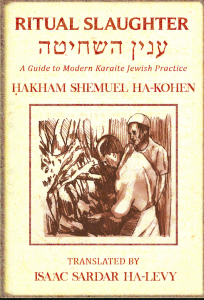 uncle, Benjamin Pessah, the last Egyptian Karaite Jew actively practicing shehita in the United States. At that time, I made a personal resolution to continue to promote Karaite shehita whenever possible. Last week, the Karaite Jews of America released a new work on Karaite shehita. The work is Ritual Slaughter: A Guide to Modern Karaite Jewish Practice.
uncle, Benjamin Pessah, the last Egyptian Karaite Jew actively practicing shehita in the United States. At that time, I made a personal resolution to continue to promote Karaite shehita whenever possible. Last week, the Karaite Jews of America released a new work on Karaite shehita. The work is Ritual Slaughter: A Guide to Modern Karaite Jewish Practice.
Today, I interview Travis Wheeler, the only shohet in the United States to be trained by the Karaite community of Israel. In fact, he was trained by H’ Moshe Firrouz, the Chief Hakham of the Council of Sages. Travis owns Six Star Meat and Poultry and recently released his Passover pricing list.
Travis Wheeler is a bit of a legend in Daly City. My aunt often asks about him. That’s kind of remarkable given how different the two are. My aunt is an Egyptian born Karaite Jewish grandmother living walking distance from the Karaite Jews of America’s synagogue. Travis Wheeler converted to Judaism through the Karaite movement and lives in Pelham, GA. Despite their different stories, they both love God and love the Karaite Jewish approach to Scripture. Without further ado, my interview:
1. How long have you been slaughtering meat, and want prompted you to become a certified Shohet?
I have slaughtered meat much of my adult life. I started in a poultry processing facility at 18 and worked with a guy who performed yield tests. The yield test was a test to compare finished meat yields from machine processing versus “controlled processing” This controlled processing is taking a live chicken (11 actually) and weighing them through each step of the process. After learning this task, I began looking into the Jewish slaughter methods and shehita. As I became a member of the Karaite community, I felt it vital to have Karaite sourced meat and poultry in the US.
2. What was the process to become a Shohet?
The process included learning the tractate on ritual slaughter (Hilchot Shehita) as well as the practical (i.e. hands-on) portion. The hands-on was quite arduous, especially with birds, when you have to ensure that you sever the 4 signs. This is not difficult in mammals but in birds it can be a process. It takes a lot of practice.
3. You have been open about the fact that you did not pass your test on your first try. What motivated you to continue?
My motivation was not for me personally but for those in the community and beyond. There are various types and stringencies of Kosher slaughter that do not meet the Karaite standards. Completing the process was vital to maintaining and growing the community.
4. What are some of the unique aspects of slaughter according to the Karaite tradition?
One of the most unique aspects of the slaughter process is that all 4 signs (esophagus, windpipe, 2 main arteries) must be severed for the bird or animal to be kosher. In the Rabbinic tradition, at least two signs must be severed. Another main difference is that we are trained to remove the sciatic nerve (or relevant ligament), from both mammals and birds. The removal of this portion from birds (as well as land animals) is attested to in Qirqisani’s Kitab al Anwar. Finally, unlike our Rabbanite brethren, we do not permit the slaughter of pregnant animals.
5. What is the biggest challenge of being a shohet.
The biggest challenge at this point is having a fully sustainable system. We are currently working on having a permanent home for our company. We plan to grow many of the animals ourselves in order to assure quality and to know where the animals are from and have been fed. We also recognize that each customer is different, so as we grow we will need to meet the needs of even the most picky eaters.
6. How do you source your meat? (For example, if we wanted free range chicken or pasture raised meat, can you get that?
I source from other farms or via animal auctions. Animals from auctions are purchased young and raised in a non-commercial setting. We have been able to get some free range chickens and I have a few beef growers who do grass-fed beef. Unfortunately these animals have a significantly higher price tag so we are wanting to breed and raise them ourselves on our company property. Our property will raise and breed lamb and chicken and I have a few people who will raise beef in Alabama.
* * *
Travis recently visited our synagogue for the Karaite Jews of America’s family Shabbat. He visits every chance he can, because that’s the kind of guy he is. I look forward to helping Travis grow awareness and interest in Karaite Shehita.
DISCLAIMER: Each person should investigate for himself/herself whether Travis’s methods meet their own kashrut, ethical and safety requirements. I do not receive any compensation from and I do not have any financial interest Six Star Meat and Poultry.
Here are some pictures of Travis’s knives and products.
And if you would like to order Ritual Slaughter, you may do so at The Karaite Press. It is currently on presale, with orders expected to ship by March 22, 2017. I do not receive any financial compensation from The Karaite Press.

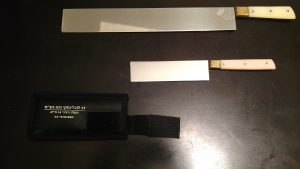
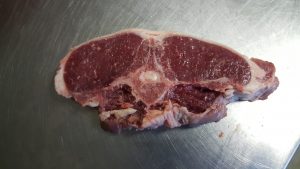
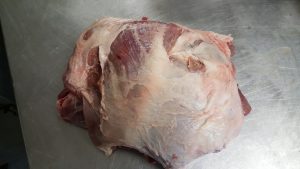
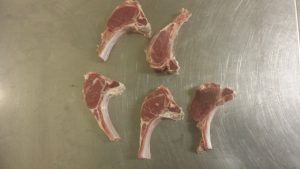

I hope the Karaite slaughter house has or will invite Temple Grandin to inspect the facility to ensure the treatment and slaughter of the animals meets her standards.
Also, traditional orthodoxy uses the unborn of slaughtered animals for Torah scrolls. Since Karaites don’t slaughter pregnant animals, what do you use for Torah scrolls?
Thank you
I only recently learned about the Torah Scrolls. Most Karaite Torah scroll today are purchased from Rabbanites. So . . .
Dedicated to Torah, The Universal Explorah…
Thank God the “Glatt Card” was not used as regards shochet Wheelers meat. Glatt is the biggest genevah of the Jewish people and affects them in all things they use or eat.
Mary makes a good point. I was skeptical but found Temple Grandin very kind and thoughtful as regards both the animals and those who consume them and their shochet middle man. She is a very wise woman.
Using the unborn for Torah Scrolls? I just lost my lunch. The Rabbinate argue whether or not if you shect a cow and find that the unborn calf is viable, then you dont need to shect it by the book according to the Rabbis because the Mothers Shecita covered the calf which was still a part of her.
But using the unborn skin for scrolls is gruesome imho.
And can anyone answer why we need a Parchment scroll of Torah when Paper would be cheaper and money spent on a roll of skin could better be spent elsewhere. Do Karaim feel that they must put the Torah on a scroll like the Rabbinate. Did a Karaite Chacham Paskan as such?
It does baffle me why the Karaites still hold by the Rabbinical practices of what constitutes a kosher scroll. Why don’t Karaites just use paper parchment (why even bother with a scroll) when it would be vastly cheaper by comparison. A shochet has to be paid an annual salary for the writing of a scroll whereas a paper scroll can be printed for about $40.00. There is stupidity and then there is stupidity.
Sorry I meant to say sofer not shochet – slaughtering on my mind.
I would take a stab at the question about the Torah scroll. My training is in the field of fine arts. We do have a lot of discussion about archiving, though that’s not my specialty. I’ve never worked with leather and ink, but the Torah scrolls seem to hold up remarkably well, much longer than I would expect from paper and print. Perhaps having a multitude of archival quality scrolls helps ensure the Torah will be preserved for future generations?
I have been questioning whether Leviticus 17:13 could answer Hashem’s shechita, ‘as He instructed’ in Deuteronomy 12:21. It seems evident that God instructs shechita in an analogy that suggests one may hunt allowable animals with a bow and arrow, just as Isaac asked his son to do. By inference, it implies that one can also humanely slaughter a domestic allowable animal or fowl and allow its blood to pour out on the soil like water, as stated in Deuteronomy 12:24.
Regarding the stranger who resides among them, I wonder who they might be and what purpose Hashem had for including a gentile in His instructions.
Thank you for any insights you can give me on these matters.
Here is Nehemia Gordon’s interpretation of ‘slaughter the animals in the manner that I have commanded you’ and why it is not a proof of the oral law.
I gave a lecture on it once and here are my abridged notes. If what I wrote isn’t clear you can listen to Gordon explain it at this link. That specific portion begins at 25 minutes. https://www.youtube.com/watch?v=E4FbqXGLTaY
But here is my understanding of what Gordon says.
First, we see that when we were wandering in the desert, we had to bring the animal as a sacrifice and if you don’t, it’s as if you committed murder
1) Lev 17:3-4 Any man of the House of Israel, who slaughters an ox, a lamb, or a goat inside the camp, or who slaughters outside the camp,
but does not bring it to the entrance of the Tent of Meeting to offer up as a sacrifice to the Lord before the Mishkan of the Lord, this [act] shall be counted for that man as blood he has shed blood, and that man shall be cut off from among his people;
Then before we enter Israel we’re given Deut 12:21
2) Deut 12:21 If the place the Lord, your God, chooses to put His Name there, will be distant from you, you may slaughter of your cattle and of your sheep, which the Lord has given you, as I have commanded you, and you may eat in your cities, according to every desire of your soul.
I also want to bring your attention to the verses that follow:
3) Deut 12:22-24
22 But as the deer and the gazelle are eaten, so may you eat them; the unclean and the clean alike may eat of them.
23 However, be strong not to eat the blood, for the blood is the soul; and you shall not eat the soul with the flesh.
24 You shall not eat it, you shall spill it on the ground, like water.
We’ll come back to verses 22-24 in a minute.
Is it possible that verse 21, ‘slaughter animals I as commanded you’ is taken out of context? Let’s look at the preceding verses in the chapter, just six verses before it.
4) In Deut 12:15-16
15 However, in every desire of your soul, you may slaughter and eat meat in all your cities (gates שְׁעָרֶ֑יךָ), according to the blessing of the Lord, your God, which He gave you; the unclean טַמֵא and the clean טַהוֹר may eat thereof, as of the deer, and as of the gazelle.
16 However, you shall not eat the blood; you shall spill it on the ground like water.
Returning to Deut 12:21-24
21 If the place the Lord, your God, chooses to put His Name there, will be distant from you, you may slaughter of your cattle and of your sheep, which the Lord has given you, as I have commanded you, and you may eat in your cities, according to every desire of your soul.
22 But as the deer and the gazelle are eaten, so may you eat them; the unclean and the clean alike may eat of them.
23 However, be strong not to eat the blood, for the blood is the soul; and you shall not eat the soul with the flesh.
24 You shall not eat it, you shall spill it on the ground, like water.
After it says “As I commanded you” the text reiterates 3 things which are cross referenced in verses 15 and 16: So let’s compare verses 15 and 16 to 21-24
7) Eat in your cities (gates) verses 15 and 21
You can eat meat like cows and sheep and the deer and gazelle, that is, whether you’re ‘pure’ or ‘not pure’ are in verses 15 and 22
Don’t eat the blood are in verses 23,24 and the preceding verse 16
In other words, “As I commanded you” is not referring to how to slaughter an animal but that you don’t have to bring an animal to the Mishchan or later, the Temple, in order to eat meat; that you can eat meat within your cities;
And just as the pure and impure people can eat deer and gazelle, the pure and the impure can eat cows and sheep;
But in neither case can you eat the blood.
Hashem’s apparent meaning is that a “stranger” gentile living among the Israelites can perform shechita in a slaughterhouse as instructed.
In today’s slaughterhouses, gentile butchers perform shechita as Hashem has instructed. The allowable animal is struck on the skull with a metal rod, instantly killing the animal without pain or suffering. (צא”ר בעלי חים)
The animal feels no pain when the neck is severed, allowing the blood to drain eventually to the soil. As God instructed, the meat in the grocery store is considered kosher.
Lev 17:12-14 seem to focus on the prohibition of not eating blood and not how to slaughter the animal; whereas the verses in Deut 12 is Moses giving us permission to eat meat whenever we want. There are no instructions as to how to slaughter an animal. The method used historically, cutting the throat, was probably considered the least harmful. In today’s non-kosher slaughter houses, typically a ‘captive bolt’, essentially a bullet to the head, is used and is probably better for the animal, and in my judgment, probably what God would prefer.
Excellent response. You intimate that G-d does not give details of shechita while Leviticus 17:12-13 states, “Therefore I say to the Israelite people: No person among you shall partake of blood, nor shall the stranger who resides among you partake of blood. And if any Israelite or any stranger who resides among them hunts down an animal or a bird that may be eaten, that person shall pour out its blood and cover it with earth.”
It seems that Hashem approves hunting allowable animals and fowl as a method of kosher slaughter for food. I believe that G-d’s merciful killing of animals and birds supersedes the ideations of aged men and sages.
Job 32:7-9 indicates Shaddai’s gift of understanding in all humans. “I thought, “Let age speak; Let advanced years declare wise things.” But truly, it is the spirit in men, The breath of Shaddai, that gives them understanding. It is not the aged who are wise, The elders, who understand how to judge.”
How was Pessah [sic] your uncle wgen you weee not born a Karaite? Like the interviewee you cane to the movement as an adult. It seems to be a common thing, even the Holocaust Revisionist Gordon makes up such stories. If you want respect honesty is a pre-requisite. For example, Gordon’s lies aside, you have yet to address the Karaite role in the Holocaust. Gordon’s lies that there were no Karaites in Europe then is absurd. All that “they were Karaylars” is pathetic. Honesty should be a pre-requisite.